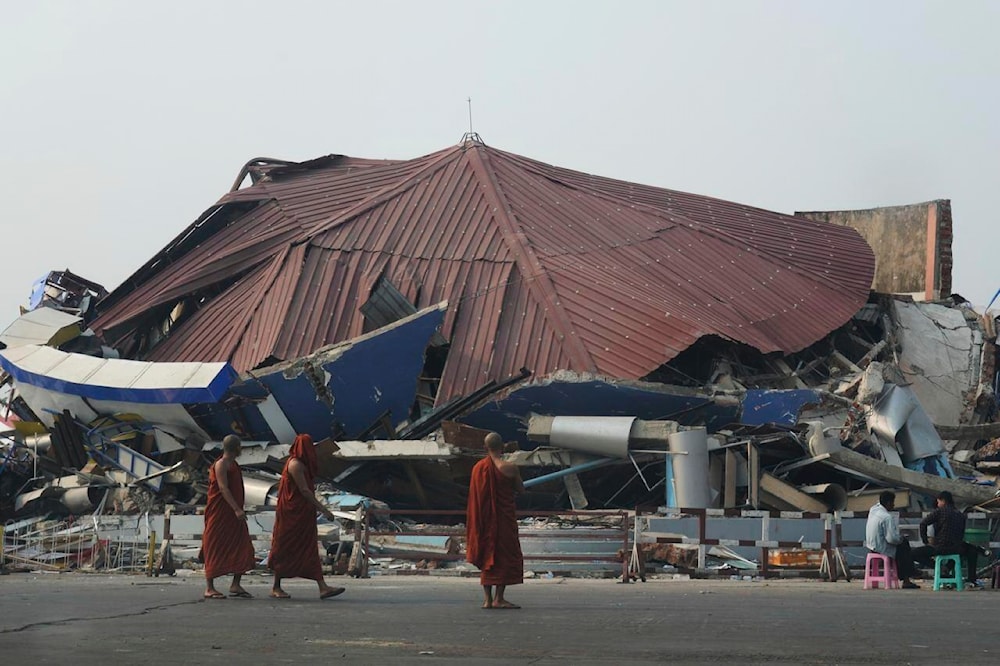Myanmar earthquake death toll surpasses 1,600
The earthquake and aftershock that hit the country on Friday were the strongest in decades, severely damaging buildings all the way in Bangkok, Thailand.
-

Buddhist monks walk past a collapsed building after a powerful earthquake in Naypyitaw, Myanmar, on Saturday, March 29, 2025 (AP)
The death toll from the earthquake that hit Myanmar on Friday has surpassed 1,600 on Saturday, as search-and-rescue efforts continue to look for survivors.
At least 1,644 people were killed, 3,400 were wounded, and at least 139 people have been reported missing in Myanmar according to a Junta statement, while in Bangkok, 10 more deaths were confirmed.
A shallow 7.7-magnitude earthquake struck the city of Sagaing in Central Myanmar on Friday afternoon, quickly followed by a 6.7-magnitude aftershock, leaving massive destruction in the city of Mandalay, home to more than 1.7 million people.
Communications are severely disrupted, concealing the true damage brought upon the military-ruled Myanmar, as the death toll is expected to increase significantly.
Victims still missing
AFP reported seeing Red Cross rescuers pulling a woman alive from under the rubble of a collapsed apartment building where over 90 people could still be trapped under the debris, according to a Red Cross official.
After hours of rescue efforts at the Sky Villa Condominium, where half of its 12 storeys had collapsed due to the quake, Phyu Lay Khaing, 30, was extracted from the debris, placed on a stretcher to be received by her husband, and transported to the hospital for medical attention.
Other individuals were less fortunate than Khaing, reported AFP.
Another woman who lived at the apartment block stated that her 20-year-old son remains missing under the rubble, "We cannot find him yet. I only have this child -- I feel so heartbroken," she told AFP, adding "He ate at my dining room and said goodbye. Then he left and the earthquake happened. If he was with me, he might have escaped like me."
In another part of Mandalay, AFP journalists observed dozens of people settling down for the night on the streets, choosing to sleep outdoors rather than risk staying in earthquake-damaged buildings.
Biggest earthquake in decades
Earthquakes are commonplace in Myanmar, which lies along the Sagaing fault, however, the 7.7-magnitude earthquake that hit the country on Friday is the biggest in decades, and the tremors severely damaged buildings in Bangkok, hundreds of kilometers away from the earthquake's epicenter.
AFP journalists witnessed a centuries-old Buddhist pagoda in Mandalay that had been reduced to rubble, while the nearby monastery also collapsed, resulting in the death of one monk and injuries to some people, as a soldier at a nearby checkpoint recounted how they pulled out some individuals and took them to the hospital.
In Bangkok, as Saturday drew into a second night, rescuers continued working to search for survivors trapped under the rubble of a collapsed 30-story skyscraper under construction.
Bangkok governor Chadchart Sittipunt informed reporters that eight people had been confirmed dead in the building collapse so far but noted that 79 were still unaccounted for at the construction site near the Chatuchak weekend market.
Sniffer dogs and thermal imaging drones were deployed to search for signs of life in the rubble, while Bangkok city authorities announced plans to dispatch over 100 engineers to inspect buildings for safety following more than 2,000 reports of damage.
'We need aid'
"We need aid," Thar Aye, 68, a Mandalay resident, told AFP, "We don't have enough of anything," he added.
Myanmar's military leader Min Aung Hlaing made an unusually rare request for international assistance on Friday, despite the country's historical reluctance under past military regimes to accept foreign aid even following catastrophic natural events.
Aid agencies have warned that Myanmar cannot handle a disaster of this scale, as approximately 3.5 million people were already displaced by the ongoing civil war—many facing hunger—even before the earthquake hit, while the UN humanitarian agency OCHA reported on Saturday that the emergency response was being hampered by a severe shortage of medical supplies and damaged roads.
International aid offers quickly materialized, as President Donald Trump pledged U.S. support while India delivered an initial assistance shipment and China deployed over 80 rescue personnel to Myanmar along with a $13.8 million emergency aid commitment.

 4 Min Read
4 Min Read








